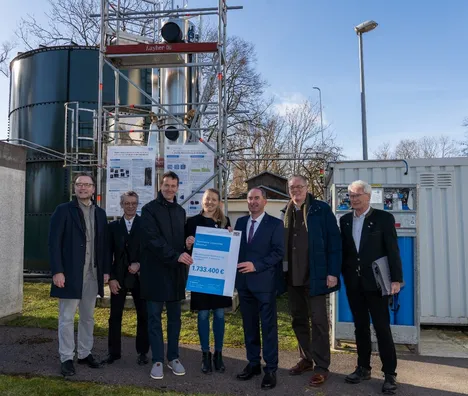Microbiological methanation - transition into commercial application (KomMeth)

In order to ensure a sustainable and secure electricity supply based on a high proportion of volatile renewable energies, long-term and demand-oriented energy storage technologies are required to stabilize the power grid in times of imbalance between energy production and demand. In Power-to-Methane technology, electricity from renewable energies is converted into methane, which can be made available as short-, medium- and long-term storage in the existing natural gas grid.
This conversion process takes place in two steps, through the production of green hydrogen (H2) from "surplus" or otherwise unproduced renewable energy and the subsequent methanation of CO2 using the H2 produced. Both pure CO2 and gas streams from industrial processes (e.g. pyrolysis gas) or simply biogas can serve as a CO2 source.
In the previous research projects MikMeth and OptiMeth, the microbiological methanation of H2 and CO2 in two trickle bed reactors on a technical scale (58 L) under thermophilic conditions was investigated and optimized for the first time. In order to demonstrate the potential of the technology on the next larger scale, a pilot reactor with an active reaction volume of 0.8 m³ was installed at the Garching wastewater treatment plant in the subsequent DemoMeth project. Raw biogas from the digester's gas storage tank was used as the CO2 source, achieving an upgrade of the biogas to a quality ready for gas grid injection. A stable methane production rate of 6 m³/(m³reactorvolume*d) was achieved in the pilot reactor.
With the aim of testing the conversion technology as a holistic concept and under real conditions, the H2 supply from gas bundles is now to be replaced by the integration of an electrolyser as part of the current KomMeth project. This coupling of electrolysis and methanation is intended to demonstrate the functionality of the overall process and identify and address any challenges that arise, for example with regard to the necessary intermediate storage of H2. In addition, various investigations are being carried out in parallel to further optimize methane productivity, process stability and the dynamic operation of the plant on a pilot plant scale. All investigations are aimed at planning a commercial pilot plant at the end of the project.
| Project Leader | Prof. Dr.-Ing. habil. Konrad Koch |
| Researcher | Christian Wenzel, M.Sc. and Xavier Niebauer, M.Sc. |
| Funding | Bavarian Ministry of Economic Affairs, Regional Development and Energy |
| Collaboration | Bavarian State Research Center for Agriculture |